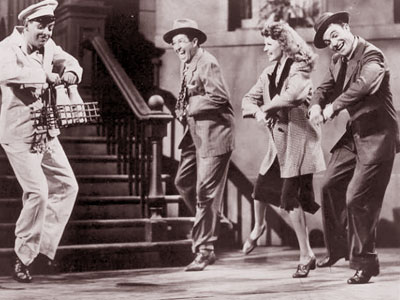
One of the more thrilling afternoons of my life came about when I had a brunch-interview with the great Phil Silvers. It took place at Nate 'n Al's delicatessen in Beverly Hills in 1982, a little less than three years before he passed away.
Expecting it to last an hour, I only brought along about 90 minutes of tape, but Mr. Silvers was in a talkative mood. This was in spite of the lingering effects of a stroke that had thickened his speech and created odd holes in his memory. He could recall the name of the landlady at a hotel he'd lived in for two weeks while touring in burlesque, but not his current phone number. He could (and did) rattle off whole pages of dialogue from plays he'd done on Broadway decades earlier but had no memory whatsoever of The Chicken Chronicles, a movie he'd made five years before our chat.
My recorder ran out of tape long before Silvers ran out of anecdotes. Fortunately, I captured this remembrance about the "Make Way for Tomorrow" dance sequence in the 1944 film classic, Cover Girl. (I did not have to edit any questions from me out of what follows. Charmingly, Silvers did not require questions. He jumped from one topic to the next without prompting. And I just sat there and listened.)
Cover Girl was another Blinky role for me. I played the same character in every movie…Blinky. The guy who ran in in the next to last reel and said, "I got the stuff in the car." I never found out in all those movies what the stuff in the car was. Cover Girl was my first good movie. In this one, Blinky was named Genius but I was still Blinky. I was Blinky in every movie I made until I did Bilko. After that, I was Bilko in everything I did, which was fine. Bilko paid a lot better than Blinky.
We made Cover Girl at Columbia. At the time, Harry Cohn was God there. There was a different God at every studio. When you worked for M.G.M., Louis B. Mayer was God. At Columbia, it was Harry Cohn. I got along with him but no one else did. He liked me because I was a gambler. I gave him tips on horses. They always lost but he didn't blame me because to a gambler, a bad tip is better than no tip at all.
A man named Charles Vidor directed Cover Girl but from where I sat, Gene Kelly was the man in charge. He and his assistant Stanley Donen took over the choreography from the man they hired to do it. I don't remember his name but he choreographed the scenes with the chorus girls and then Kelly did everything else. Stanley Donen did some of it but it was mainly Gene. There was this song, "Make Way for Tomorrow." It was supposed to be a six minute dance down the street with Rita Hayworth and Gene dancing and leaping over trash cans and doing cartwheels. I watched them rehearse it for three days and I thought, "Thank God I don't have to do that."
The fourth day, Gene came over to me and said, "I think it would strengthen the story if you were in the number." There was a drunk who had a tiny part in it. I think it was Jack Norton, who was the drunk in any movie that had a drunk in it. I thought Gene meant I'd do a little bit like that in the number so I said, "Yes, sure, I'll do whatever you want." The next thing I know, Gene and Stanley had redesigned the whole number for three people and I was one of those three people.
He did not design it for a non-dancer, which is what I was. It was designed for Gene and Rita, who were the two best dancers in the business. I had to come up to their standard. They danced up and down stairs. I had to dance up and down stairs. They leaped over boxes. I had to leap over boxes. All the time, I'm thinking, "I'm dancing next to Gene Kelly, doing the same steps. Everybody's going to be comparing us. If we're out of step, no one's going to assume Gene's the one who's wrong. Gene was still a newcomer on screen but everyone knew he was the best dancer to come along.
It was rough. They were going to shoot it in pieces but Gene insisted we rehearse it straight through, start to end. I don't remember how long it took to learn. Rita, I think, required four weeks. It must have been longer with me but I did it. Whatever Gene and Rita did, I did, and I did it as well as they did. And Gene was right. It did strengthen the story. It was a surprise for me to be in that number and to dance it like that. When we were done shooting, I ached all over. Every muscle in my body hurt. But I felt like I could do anything.
In later years, every time I had something to do in a film or a TV show that I thought I couldn't do, I thought back to that number. And I said to myself, "If you can do that, you can do anything."
Phil Silvers was, indeed, a man who could do anything. Later, after the tape recorder was no longer running, he lamented the physical problems from his stroke and said, "If I could do that number in Cover Girl, I ought to be able to walk across the street on my own, don't you think?"